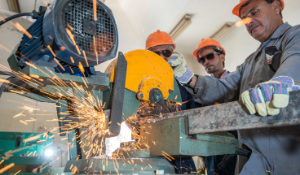Prevent It


Do you know How to Decrease your Manufacturing Injury Costs?
 Tasks in the manufacturing industry are inherently physical. So, it stands to reason that musculoskeletal (MSK) wellness would be critical to employee productivity. Workers' mobility, balance, agility, and coordination all rely on the musculoskeletal system. Specific work activities including, prolonged time standing, repetitive physical tasks, heavy lifting, awkward postures or reaches, and limited rest time between activities, are integral to job performance. Unfortunately, these movements also put manufacturing employees at an increased risk for MSK disorders (MSKD), such as sprains and strains of muscle, nerves, joints, ligaments, and tendons.
Tasks in the manufacturing industry are inherently physical. So, it stands to reason that musculoskeletal (MSK) wellness would be critical to employee productivity. Workers' mobility, balance, agility, and coordination all rely on the musculoskeletal system. Specific work activities including, prolonged time standing, repetitive physical tasks, heavy lifting, awkward postures or reaches, and limited rest time between activities, are integral to job performance. Unfortunately, these movements also put manufacturing employees at an increased risk for MSK disorders (MSKD), such as sprains and strains of muscle, nerves, joints, ligaments, and tendons.
The Impact of MSK Disorders on the Manufacturing Workforce
According to Travelers Insurance's Injury Impact Report, sprains and strains are the most common workplace injury. Workers average 57 days away from work because of sprains and strains, and the average claim cost from them is $17,000. The most common way employees are injured from material handling is lifting, lowering, filling, emptying, or carrying an item.
Approximately 35-50% of all workforce injuries are related to soft tissue injuries. Furthermore, MSD injuries account for more healthcare spending than any other single health condition. Add to that, MSD problems also result in a significant decrease in suboptimal workforce productivity due to presenteeism's health conditions.
Employees with an MSK disorder, such as chronic back or joint pain, are costlier and less productive than their counterparts without chronic pain. Plus, when MSD causes permanent disabilities, employees incur the costs of new hiring and training.
Case Study: A Practical Approach to Addressing MSK Disorders
A Fortune 500 international manufacturing firm was losing millions of dollars in workers' compensation claims annually. The high frequency and severity of soft tissue injuries amongst employees resulted in extensive off-site provider treatments, long healing cycles, and disruptions of routine work schedules.
Introducing a comprehensive onsite injury prevention and care program dramatically reduced the incidence, seriousness, and cost of soft tissue injuries. Utilizing early intervention and job coaching resolved many issues instigating and amplifying employees' soft tissue injuries. The onsite physical therapists (PT) performed ergonomic assessments and created workable solutions for employees in real-time. Access to prompt onsite care is a popular perk for the company's employees.
The manufacturing firm reaped an annual savings of $5.5 million across its ten facilities and experienced a reduction of 59% in worker's compensation costs. At the same time, the ensuing reduced work schedule disruptions improved productivity levels. The manufacturing company found having onsite PT spending time on its production floor, working with employees and department supervisors in real-time to address and ergonomic concerns that might be contributing to its MSD symptoms incredibly beneficial.
Benefits of Comprehensive Onsite Injury Prevention and Care Program
A comprehensive onsite injury prevention and care program is a vital component of a positive safety culture. Onsite physical therapists providing post-offer employment and fit for duty testing, functional job analysis, ergonomics, functional capacity evaluations, and work-ready programs give manufacturers a foundation for a proactive approach to managing and averting MSK injuries. Onsite PTs can also modify the job description or environment (i.e., standing for long periods can be modified to sitting) to bring the employee back to work sooner and more safely. Alternatively, outside physical therapists that don't have intimate knowledge of the functional job description may not make an accurate assessment on whether the employee is ready to go back to work.
MSK spend significantly reduced as onsite PTs ensure that employment candidates can safely do their job, saving manufacturers millions of dollars yearly in worker's compensation claims. Onsite PTs decrease injury risk by working with symptomatic employees to alleviate the symptoms before an expensive claim is filed, which reduces worker's compensation costs. Proactively working with employees on ergonomics assessments and work conditioning dramatically improves productivity and reduces injuries.
Learn How Manufacturing Firm WaferTech Reduced Workers' Compensation Claims By 40% With Onsite PT Services.
Learn more about manufacturing ergonomics in the following posts:
- Boost Your Ergonomics Committee's Impact
- Industrial Ergonomic Assessments - How to Get the Best Value from Them
- WorkWell Unveils New Ergonomics On-Demand! Training
- Why Proactive Manufacturing Ergonomics Are Effective at Reducing Injuries
- New Industrial and Office Ergonomics Programs from WorkWell
- 5 Early Intervention Tips to Prevent Manufacturing Injuries
Select a topic
- View all topics
- WorkWell
- Safety Culture
- Onsite PT Clinics
- Ergonomics
- Injury/Illness Prevention
- Employee Wellness
- MSK
- Industry News
- POET
- Safety
- Managed Services
- Manufacturing
- Functional Job Descriptions
- Onsite PT
- FJD
- Post Offer Employment Training
- Provider Network
- Blog
- Events
- Featured
- OSHA
- Work Readiness
- Company News
- Job Coaching
- MSK Strategy
- Musculoskeletal
- PT Solutions Employee
- Presenteeism
- Push/Pull
- Recruitment
- Training
- Trust
- Worksite Rounds
Subscribe to Our Blog
Practical tips focused on workplace injury prevention.
Featured Posts
postsTags [BlogPost 178613021575 Shift to Prevention and End the Game of Whack-a-Mole, BlogPost 125116526205 Why now is the time for a Managed Onsite MSK Clinic]
.png)

